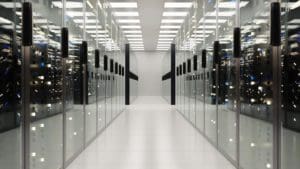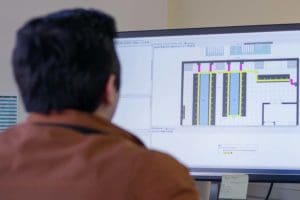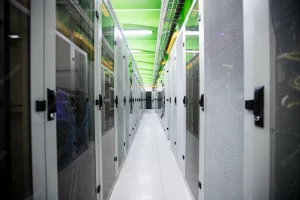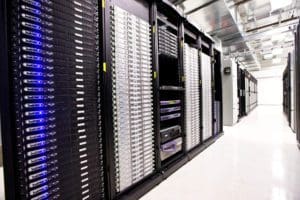Data center design is crucial for optimising operational efficiency and reducing energy costs. At EziBlank, we understand the unique challenges faced by data centre professionals and are dedicated to providing innovative solutions that enhance airflow management and energy monitoring. Our expertly crafted blanking panels not only streamline your data centre's performance but also deliver a rapid return on investment. Explore how our intelligent systems can safeguard your infrastructure investment and elevate your data centre's capabilities to new heights. Let us partner with you on this journey towards a sustainable and efficient future.
What are the different types of data centers?
Data centres are the backbone of modern digital operations, and they come in various forms to meet diverse needs. From enterprise data centres that are privately owned and operated by a single organisation to colocation facilities where multiple businesses share the space, each type is designed to address specific operational requirements. Hyperscale data centres, with their vast capacity, support massive cloud computing needs, while edge data centres bring processing power closer to the source of data generation, reducing latency. Understanding these different types of data centres is essential for businesses looking to optimise their digital infrastructure.
Read More
Why Are Data Centers Important?
In an increasingly connected world, data centres have become the unsung heroes of our digital lives, powering everything from online shopping to streaming services and complex AI operations. These critical facilities store, process, and distribute vast amounts of data, ensuring that businesses and individuals can access the digital tools and information they need in real-time. The importance of data centres extends beyond mere storage; they are integral to the functioning of our digital economy, providing the backbone for everything from everyday internet usage to the advanced computing required for innovation and growth.
Read More
Design Aesthetics in Data Centres
While functionality and efficiency are paramount in data centre design, aesthetics also play a significant role in creating a cohesive and professional environment. Modern data centres are increasingly incorporating design elements that reflect the brand's identity and enhance the visual appeal of the facility. This includes the strategic use of colours, materials, and layouts that not only make the space more visually pleasing but also support operational efficiency. For instance, the integration of aesthetically designed blanking panels can contribute to a cleaner, more organised appearance while improving airflow management. Balancing form and function in data centre design helps create an environment that is both efficient and visually engaging.
Read More
How much does it cost to build a data center?
The cost of building a data centre can vary widely depending on factors such as location, size, design specifications, and the level of technology incorporated. On average, constructing a small to mid-sized data centre can range from several million to tens of millions of dollars. Larger, hyperscale data centres, which are designed to support massive computing needs, can cost hundreds of millions to over a billion dollars. These costs include land acquisition, construction, electrical and cooling infrastructure, security systems, and the installation of servers and networking equipment. Additionally, ongoing operational costs such as energy, maintenance, and staffing must be factored into the total investment, making data centres a significant financial commitment for any organisation.
Read More
Cold Aisle Containment Solutions & Products
Cold aisle containment is a highly effective strategy for improving the efficiency and performance of data centre cooling systems. This approach involves physically separating the cold air used for cooling servers from the hot exhaust air, typically by enclosing the cold aisle where the server fronts are located. By preventing the mixing of hot and cold air, cold aisle containment ensures that cooling is more targeted and efficient, reducing energy consumption and lowering operational costs. Products designed for cold aisle containment, such as doors, ceiling panels, and blanking panels, help maintain a stable, cool environment within the aisle, allowing data centres to operate more efficiently and sustainably. This solution is particularly valuable in high-density environments where cooling demands are significant.
Read More
Hot Aisle vs Cold Aisle Containment
Hot aisle and cold aisle containment are two critical strategies used in data centres to enhance cooling efficiency and reduce energy consumption. In a cold aisle containment setup, cold air is contained within the aisle where the fronts of the server racks face each other, ensuring that only cool air is delivered directly to the equipment. This prevents the mixing of cold air with hot exhaust air, improving cooling efficiency. Conversely, hot aisle containment involves enclosing the aisle where the backs of the servers expel hot air. This containment captures and directs the hot air back to the cooling systems, preventing it from mixing with the cool air in the room. Both methods are effective, but the choice between hot and cold aisle containment depends on the specific design and cooling needs of the data centre. Implementing either strategy can lead to significant improvements in energy efficiency and overall system performance.
Read More
Designing an Energy-Efficient Data Center
Designing an energy-efficient data centre requires a strategic approach that combines advanced technology with best practices in layout and infrastructure management. The foundation of an energy-efficient design begins with optimising the physical layout, such as implementing hot and cold aisle containment to prevent the mixing of hot and cold air, which significantly reduces the burden on cooling systems. Incorporating energy-efficient hardware, such as servers and storage devices that consume less power, is also crucial. Additionally, leveraging renewable energy sources like solar or wind power can greatly reduce the carbon footprint of the facility. Effective monitoring and management tools are essential for tracking energy use and making real-time adjustments to improve efficiency. By focusing on these elements, a data centre can achieve optimal performance while minimising energy consumption and operational costs.
Read More
Guide to setting up a Data Center
Setting up a data centre requires careful planning and execution to ensure that the facility meets both current and future needs. The process begins with selecting an appropriate location that offers reliable power, cooling, and connectivity. The physical design of the data centre should incorporate efficient layout strategies, such as hot and cold aisle containment, to optimise airflow and cooling efficiency. Equipping the data centre with scalable infrastructure, including modular server racks and energy-efficient hardware, allows for future growth without major overhauls. Additionally, implementing robust power management systems, such as uninterruptible power supplies (UPS) and backup generators, is critical for ensuring continuous operation. Security measures, both physical and digital, must be in place to protect the data and infrastructure. Finally, ongoing monitoring and maintenance plans should be established to keep the data centre operating at peak performance. By following this guide, you can set up a data centre that is efficient, secure, and scalable.
Read More
Green Data Center Case Study
A green data centre case study highlights how implementing sustainable practices can lead to significant environmental and financial benefits. In one example, a data centre achieved substantial energy savings by integrating renewable energy sources such as solar and wind power into its operations. Additionally, the facility utilised advanced cooling technologies, including free cooling and liquid cooling systems, which drastically reduced the reliance on traditional, energy-intensive air conditioning. The implementation of hot and cold aisle containment systems further optimised airflow, minimising energy waste. Through these initiatives, the data centre not only reduced its carbon footprint but also realised considerable cost savings, demonstrating that sustainability and efficiency can go hand in hand. This case study serves as a model for other facilities aiming to transition towards greener, more energy-efficient operations.
Read More
How to Manage Airflow in a Data Center
Managing airflow in a data centre is crucial for maintaining optimal cooling efficiency and ensuring the longevity of equipment. Effective airflow management begins with the strategic placement of blanking panels in server racks to eliminate gaps, which prevents hot air from recirculating and ensures that cool air is directed precisely where it’s needed. Implementing hot and cold aisle containment systems further enhances airflow by separating the hot exhaust air from the cool intake air, reducing the workload on cooling systems. Proper cable management is also essential to avoid obstructions that can disrupt airflow patterns. Additionally, using perforated floor tiles in the raised floor environment helps channel cool air directly to the servers. Regular monitoring and adjustments based on real-time data are necessary to maintain efficient airflow and adapt to changes in the data centre’s layout or load. These strategies collectively help optimise cooling, reduce energy consumption, and improve the overall performance of the data centre.
Read More
The Ultimate Guide to Data Centers
Data centres are the backbone of the digital world, housing the servers and networking equipment that power everything from websites to cloud computing services. A well-designed data centre must balance performance, efficiency, and security, with key considerations including location, infrastructure, power supply, cooling systems, and security measures. Effective airflow management, such as the use of blanking panels and hot/cold aisle containment, is essential for maintaining optimal temperatures and reducing energy consumption. Additionally, data centres must incorporate robust backup systems, such as uninterruptible power supplies (UPS) and generators, to ensure continuous operation in the event of power failures. As businesses increasingly rely on digital infrastructure, the role of data centres continues to expand, making it crucial to optimise their design and operations for reliability, efficiency, and scalability.
Read More
